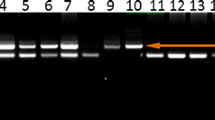Abstract
IL-18, initially defined as a potent inducer of IFN- γ production, is a systemic, multifunctional cytokine with both pro-cancerous and anti-cancer activities. The contribution of the IL-18 promoter polymorphisms at positions −607 (C/A) and −137 (G/C) to cancer development has been reported. We sought to examine IL-18 serum level and its polymorphisms in Iranian women with ovarian cancer. Single nucleotide polymorphisms (SNPs) at positions −607 (C/A) and −137 (G/C) were analyzed by allele-specific polymerase chain reaction in 85 women with ovarian cancer and 158 healthy controls. IL-18 serum level was determined using ELISA method. No significant association was found between the allele, genotype, and haplotype distributions of the SNPs and ovarian cancer. Mean IL-18 serum level was significantly higher in patients than in controls (P = 0.008). Comparing IL-18 serum levels with genotypes at positions −607 and −137 revealed no significant difference. No association was also found between IL-18 levels and the disease stage. In conclusion, our results indicate that IL-18 promoter polymorphisms at positions −607 (C/A) and −137 (G/C) appear not to confer susceptibility to ovarian cancer in Iranian population; however, IL-18 serum level increases in ovarian cancer patients.
Similar content being viewed by others
References
Parkin DM, Bray F, Ferlay J et al (2001) Estimating the world cancer burden: globocan 2000. Int J Cancer 94:153–156. doi:10.1002/ijc.1440
Ness RB, Grisso JA, cottreau C et al (2000) Factors related to inflammation of the ovarian epithelium and risk of ovarian cancer. Epidemiology 11:111–117. doi:10.1097/00001648-200003000-00006
Bushley AW, Ferrell R, McDuffie K et al (2004) Polymorphisms of interleukin (IL)-1alpha, IL-1beta, IL-6, IL-10, and IL-18 and the risk of ovarian cancer. Gynecol Oncol 95:672–679. doi:10.1016/j.ygyno.2004.08.024
Aggarwal BB, Shishodia S, Sandur SK et al (2006) Inflammation and cancer: how hot is the link? Biochem Pharmacol 72:1605–1621. doi:10.1016/j.bcp.2006.06.029
Park S, Cheon S, Cho D (2007) The dual effects of interleukin-18 in tumor progression. Cell Mol Immunol 4:329–335
Khalili-Azad T, Razmkhah M, Ghiam AF et al (2009) Association of Interleukin-18 gene promoter polymorphisms with breast cancer. Neoplasma 56:20–23
Nakanishi K, Yoshimoto T, Tsutsui H et al (2001) Interleukin-18 is a unique cytokine that stimulates both Th1 and Th2 responses depending on its cytokine milieu. Cytokine Growth Factor Rev 12:53–72. doi:10.1016/S1359-6101(00)00015-0
Vidal-Vanaclocha F, Mendoza L, Telleria N et al (2006) Clinical and experimental approaches to the pathophysiology of interleukin-18 in cancer progression. Cancer Metastasis Rev 25:417–434. doi:10.1007/s10555-006-9013-3
Bornstein SR, Rutkowski H, Vrezas I, Bornstein SR et al (2004) Cytokines and steroidogenesis. Mol Cell Endocrinol 215:135–141. doi:10.1016/j.mce.2003.11.022
Gaggero A, De Ambrosis A, Mezzanzanica D et al (2004) A novel isoform of pro-interleukin-18 expressed in ovarian tumors is resistant to caspase-1 and -4 processing. Oncogene 23:7552–7560. doi:10.1038/sj.onc.1208036
Akahiro J, Konno R, Ito K, Okamura K et al (2004) Impact of serum interleukin-18 level as a prognostic indicator in patients with epithelial ovarian carcinoma. Int J Clin Oncol 9:42–46. doi:10.1007/s10147-003-0360-6
Le Page C, Ouellet V, Madore J et al (2006) From gene profiling to diagnostic markers: IL-18 and FGF-2 complement CA125 as serum-based markers in epithelial ovarian cancer. Int J Cancer 118:1750–1758. doi:10.1002/ijc.21521
Gunel N, Coskun U, Sancak B et al (2002) Clinical importance of serum interleukin-18 and nitric oxide activities in breast carcinoma patients. Cancer 95:663–667. doi:10.1002/cncr.10705
Tsuboi K, Miyazaki T, Nakajima M et al (2004) Serum interleukin-12 and interleukin-18 levels as a tumor marker in patients with esophageal carcinoma. Cancer Lett 205:207–214. doi:10.1016/j.canlet.2003.10.010
Kawabata T, Ichikura T, Majima T et al (2001) Preoperative serum interleukin-18 level as a postoperative prognostic marker in patients with gastric carcinoma. Cancer 92:2050–2055. doi:10.1002/1097-0142(20011015)92:8<2050::AID-CNCR1544>3.0.CO;2-5
Jebreel A, Mistry D, Loke D et al (2007) Investigation of interleukin 10, 12 and 18 levels in patients with head and neck cancer. J Laryngol Otol 121:246–252. doi:10.1017/S0022215106002428
Giedraitis V, He B, Huang WX et al (2001) Cloning and mutation analysis of the human IL-18 promoter: a possible role of polymorphisms in expression regulation. J Neuroimmunol 112:146–152. doi:10.1016/S0165-5728(00)00407-0
Bai J, Zhang Y, Lin M et al (2007) Interleukin-18 gene polymorphisms and haplotypes in patients with oral lichen planus: a study in an ethnic Chinese cohort. Tissue Antigens 70:390–397. doi:10.1111/j.1399-0039.2007.00922.x
Liu Y, Lin N, Huang L et al (2007) Genetic polymorphisms of the interleukin-18 gene and risk of prostate cancer. DNA Cell Biol 26:613–618. doi:10.1089/dna.2007.0600
Wei YS, Lan Y, Liu YG et al (2007) Interleukin-18 gene promoter polymorphisms and the risk of esophageal squamous cell carcinoma. Acta Oncol 46:1090–1096. doi:10.1080/02841860701373595
Asefi V, Mojtahedi Z, Khademi B et al (2008) Head and neck squamous cell carcinoma is not associated with interleukin-18 promoter gene polymorphisms: a case-control study. J Laryngol Otol. doi:10.1017/S0022215108003733
Miller SA, Dykes DD, Polesky HF (1988) A simple salting out procedure for extracting DNA from human nucleated cells. Nucleic Acids Res 16:1215. doi:10.1093/nar/16.3.1215
Osaki T, Péron JM, Cai Q et al (1998) IFN-gamma-inducing factor/IL-18 administration mediates IFN-gamma- and IL-12-independent antitumor effects. J Immunol 160:1742–1749
Park H, Byun D, Kim TS et al (2001) Enhanced IL-18 expression in common skin tumors. Immunol Lett 79:215–219. doi:10.1016/S0165-2478(01)00278-4
Acknowledgments
The authors thank to Dr Nasrollah Erfani for his assistance in statistical analysis. This work was supported by a grant from Shiraz Institute for Cancer Research (Grant number: CR83-110).
Author information
Authors and Affiliations
Corresponding author
Rights and permissions
About this article
Cite this article
Samsami Dehaghani, A., Shahriary, K., Kashef, M.A. et al. Interleukin-18 gene promoter and serum level in women with ovarian cancer. Mol Biol Rep 36, 2393–2397 (2009). https://doi.org/10.1007/s11033-009-9469-7
Received:
Accepted:
Published:
Issue Date:
DOI: https://doi.org/10.1007/s11033-009-9469-7




